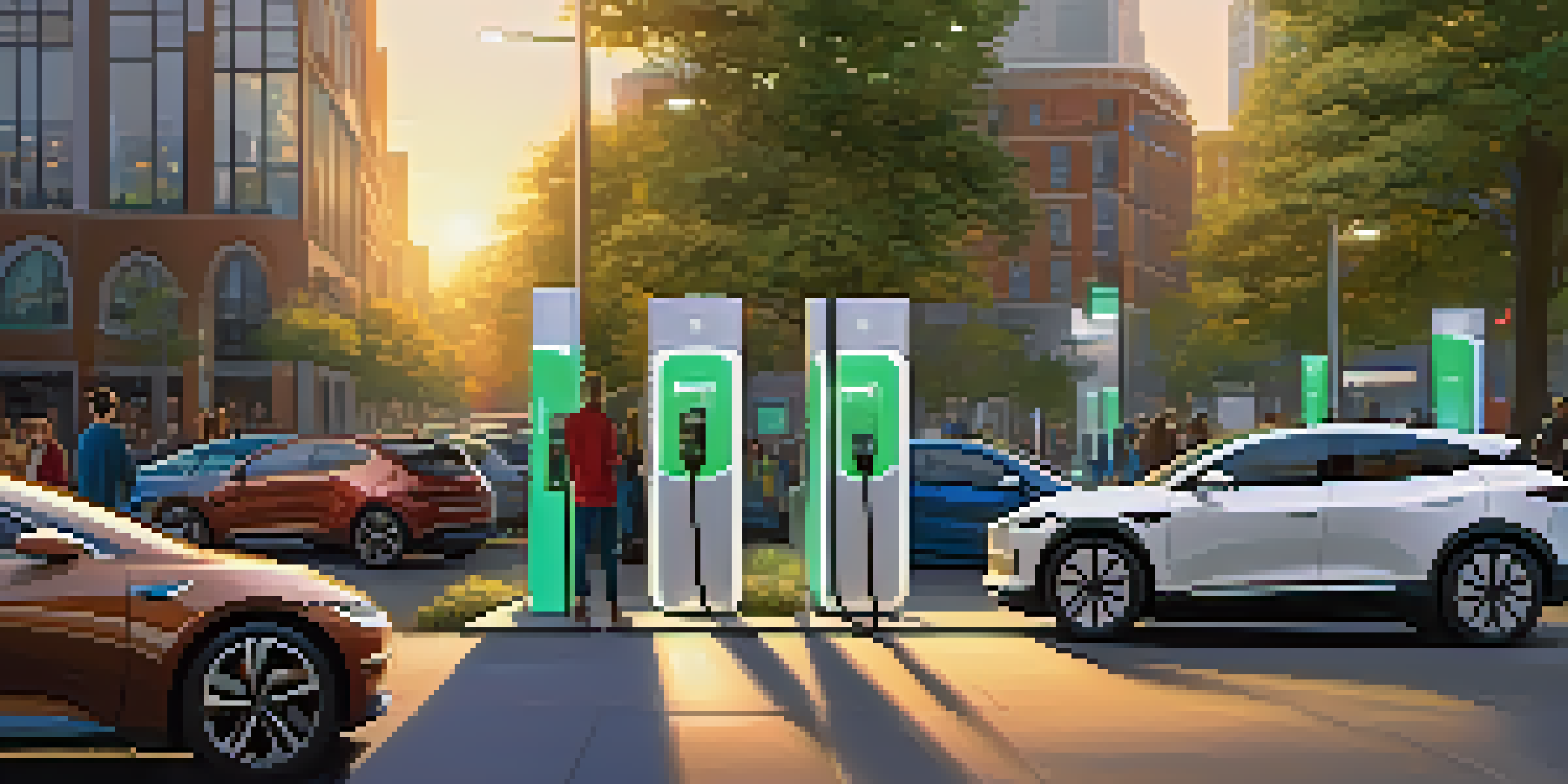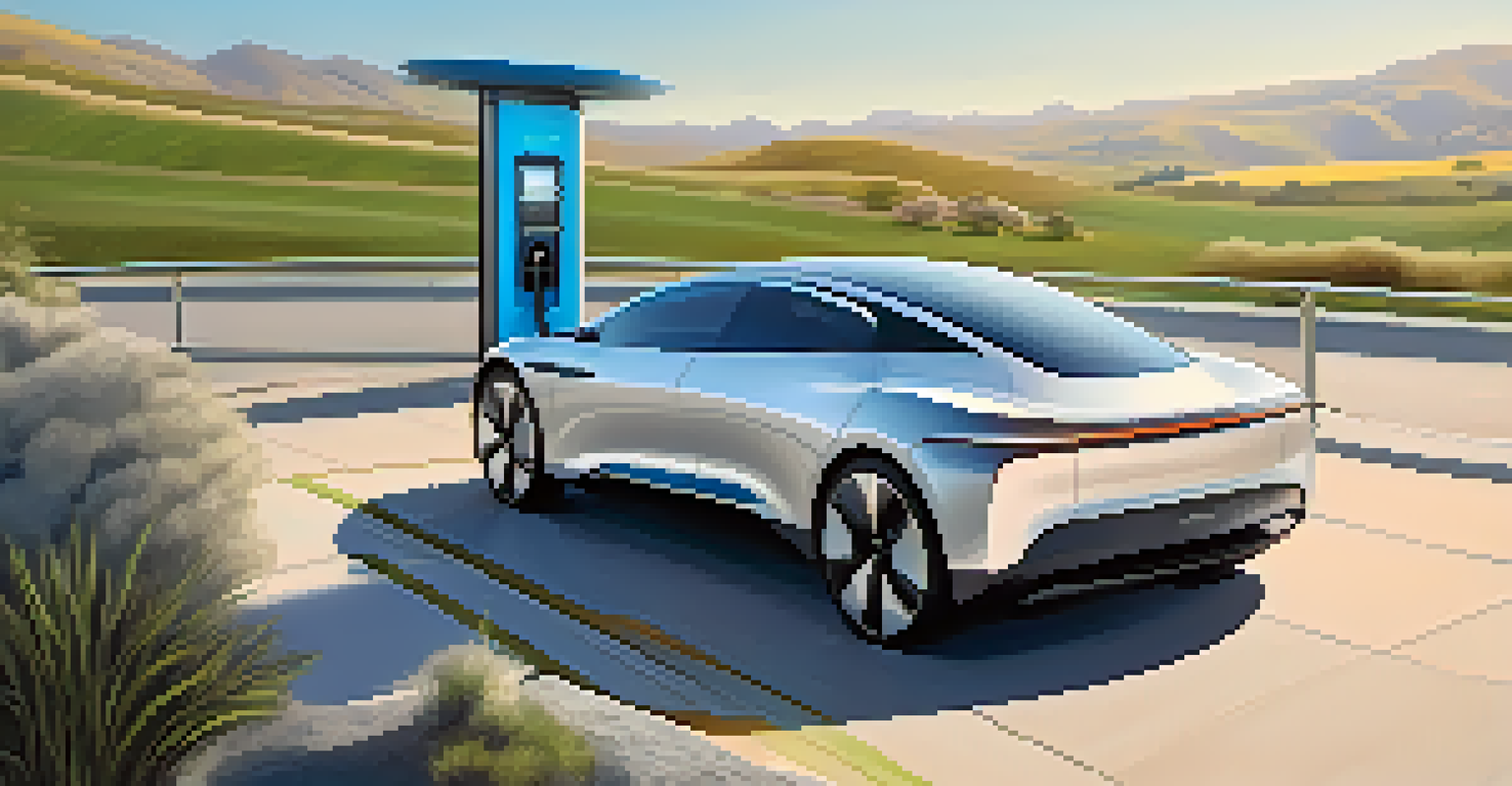The Role of Charging Infrastructure in EV Adoption Rates

Understanding Electric Vehicle Adoption Rates
Electric vehicle (EV) adoption rates have been steadily increasing, but what drives this trend? Various factors, including environmental awareness, fuel prices, and technological advancements, play a significant role. However, one of the most critical components is the availability of charging infrastructure. Without sufficient charging points, potential buyers may hesitate to make the switch to electric.
The future is electric. It's just a matter of how fast we can get there.
Imagine deciding to shift from a traditional gas-powered car to an EV, only to find there are limited places to recharge. This scenario illustrates the importance of accessible and reliable charging stations in facilitating the transition to electric mobility. As more consumers consider EVs, the lack of charging infrastructure can create a barrier, preventing widespread adoption.
In areas where charging stations are plentiful, we often see a higher rate of EV purchases. This correlation highlights how essential it is for cities and communities to invest in charging facilities to support the growing demand for electric vehicles.
The Types of Charging Infrastructure Available
Charging infrastructure can be broadly categorized into three types: Level 1, Level 2, and DC fast charging. Level 1 chargers are standard home outlets that provide the slowest charging speeds, while Level 2 chargers are more common in public spaces and can charge an EV more quickly. DC fast chargers, on the other hand, offer rapid charging capabilities, making them ideal for long-distance travel.

To put this into perspective, think of Level 1 charging as a slow drip, while DC fast charging is like a fire hose. Each type of charger serves a distinct purpose and caters to different driving habits. For daily commuters, Level 2 chargers might suffice, but those embarking on road trips will benefit immensely from the speed of DC fast chargers.
Charging Infrastructure Drives EV Adoption
The availability of accessible charging stations is crucial for encouraging potential buyers to switch to electric vehicles.
Understanding these types of charging infrastructure helps potential EV owners make informed decisions about their charging needs. As the market for electric vehicles grows, so does the variety and availability of charging stations, catering to a wider audience.
The Role of Public Charging Stations
Public charging stations play a pivotal role in EV adoption, acting as a safety net for drivers who may not have access to home charging. These stations are essential in urban areas where many residents live in apartments or condos without dedicated parking spaces. The presence of convenient public chargers can alleviate range anxiety, a common concern among potential EV buyers.
If we want to make electric vehicles accessible to everyone, we need to invest in charging infrastructure.
Imagine planning a road trip in an electric vehicle, only to realize your destination lacks sufficient charging options. This scenario can deter even the most enthusiastic EV advocates. Public charging stations ensure that drivers can confidently embark on longer journeys without worrying about running out of power.
Moreover, the strategic placement of public charging stations can influence consumer behavior positively. Cities that prioritize the development of charging networks not only support existing EV drivers but also attract new ones, ultimately boosting local economies and promoting sustainable transportation.
The Importance of Home Charging Solutions
Home charging solutions are a significant factor in the decision-making process for potential EV buyers. Having a dedicated charging station at home can make owning an electric vehicle incredibly convenient. Many EV owners charge their vehicles overnight, waking up to a full battery each morning, which is a huge advantage over traditional cars.
Think of home charging as a personal fueling station—it's always there when you need it. The ability to charge at home eliminates the hassle of seeking out public chargers, especially after a long day. As a result, homeowners are often more inclined to invest in electric vehicles when they know they can charge their cars conveniently.
Home Charging Enhances Convenience
Having a dedicated home charging solution makes owning an electric vehicle more practical and appealing for many consumers.
Additionally, the installation of home charging stations can increase property value, making it a win-win situation for homeowners. As more people recognize this benefit, the demand for electric vehicles is likely to rise, further reinforcing the importance of robust charging infrastructure.
Government Incentives and Policies
Government incentives and policies play a crucial role in promoting the development of charging infrastructure. Many countries and local governments offer tax credits, grants, and subsidies to encourage the installation of charging stations. These initiatives not only support businesses and homeowners but also signal to consumers that electric vehicles are a viable option.
Consider the impact of these incentives: when the cost of installing a charging station is significantly reduced, more businesses are likely to invest in EV infrastructure. This creates a ripple effect, leading to increased accessibility for consumers and ultimately higher adoption rates of electric vehicles.
Furthermore, robust policies aimed at expanding charging networks can help drive innovation in the EV sector. As charging technology improves and becomes more efficient, it will attract even more consumers, paving the way for a cleaner, greener future.
Challenges Facing Charging Infrastructure Development
Despite the growing demand for EV charging infrastructure, several challenges persist. One significant hurdle is the high cost of installation, which can deter businesses and municipalities from investing in new charging stations. Additionally, the rapid pace of technological advancements means that today’s infrastructure might become obsolete in just a few years.
For instance, community planners must balance the need for immediate charging solutions with the long-term vision of integrating more advanced technology in the future. This balancing act can lead to confusion and hesitance among stakeholders, ultimately slowing progress.
Government Support Boosts Infrastructure
Incentives and policies from governments play a key role in expanding charging networks and promoting electric vehicle adoption.
Moreover, local regulations and zoning laws can complicate the installation of charging stations, creating further barriers. Addressing these challenges is essential for ensuring that charging infrastructure keeps pace with the growing demand for electric vehicles.
Future Trends in Charging Infrastructure
Looking ahead, several trends are likely to shape the future of charging infrastructure. One key trend is the expansion of ultra-fast charging networks, which will allow for quicker recharging times and greater convenience for EV drivers. This advancement could significantly reduce range anxiety and encourage more consumers to make the switch to electric vehicles.
Another exciting development is the rise of smart charging technology, which enables users to optimize charging times based on electricity rates and grid demand. Imagine being able to charge your EV during off-peak hours, saving money while contributing to a more sustainable energy grid. This not only benefits individual users but also supports the overall electricity infrastructure.

As electric vehicles continue to gain popularity, the integration of charging infrastructure with renewable energy sources is also on the horizon. By harnessing solar or wind power for charging stations, we can make electric vehicle adoption even more eco-friendly, further encouraging consumers to embrace this transformative technology.